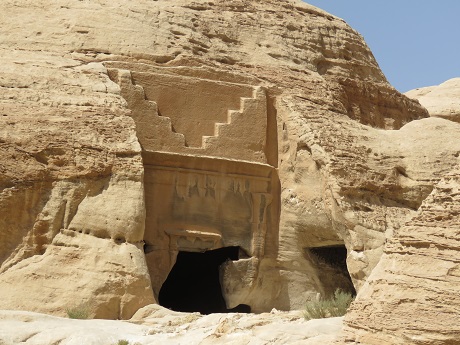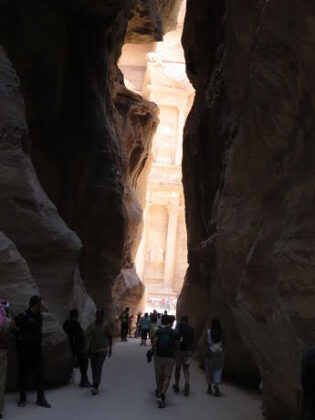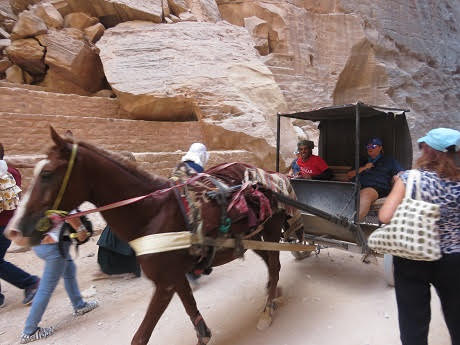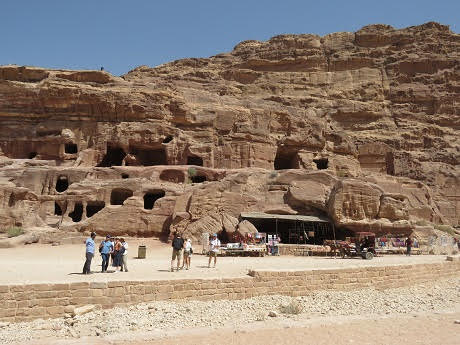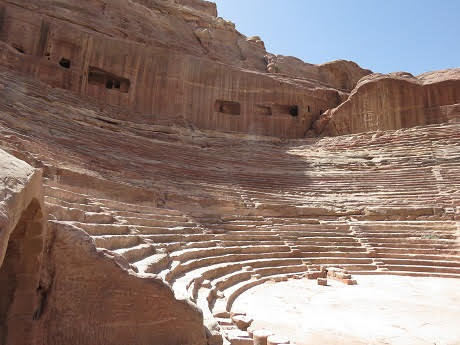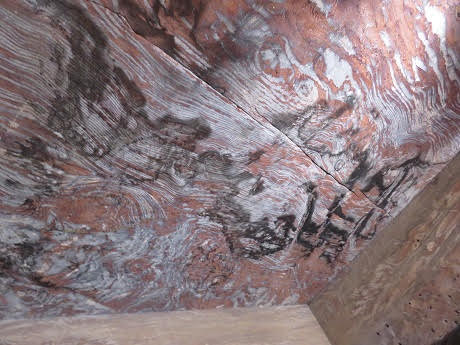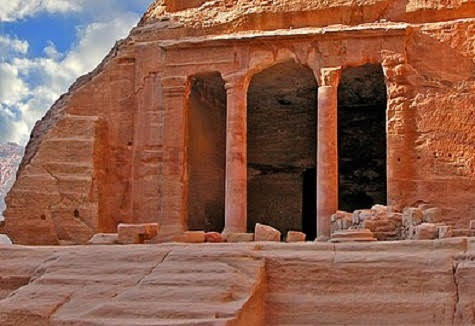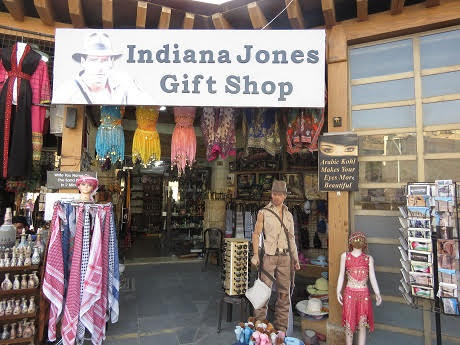By TR Robertson
The primary destination for tourists visiting Jordan, other than the Dead Sea, is the historic archaeological city of Petra, a UNESCO World Heritage site since 1985. Petra is in southern Jordan next to the Jabal Al-Madbah mountain that is next to a basin surrounded by other mountains that form the eastern flank of the Arabah Valley running from the Dead Sea to the Gulf of Aqaba. This unique land formation has been inhabited by people since 7,000 BC. The majestic city of Petra has been the background for many movies, most notably the famous scene when Indiana Jones, in the 1989 “Indiana Jones and the Last Crusade”, rides through the passageway leading up to Al-Khazna, The Treasury. Petra can also be seen in the movies “The Mummy Returns,” “Passion in the Desert,” and “Mortal Kombat.” After morning breakfast at our hotel, our packed luggage was loaded on the bus as we boarded our bus for the drive from Aqaba to the town of Wadi Musa and the entrance to Petra.
Petra was voted one of the New 7 Wonders of the World in 2007, joining the Great Wall of China, Machu Picchu in Peru, the Colosseum of Rome, Chichen Itza in the Yucatan, the Taj Mahal in India, Christ the Redeemer in Brazil, and the Giza Pyramid of Egypt (an Honorary member).
As our bus turned off the main highway to head toward the city of Petra, we stopped for a bathroom break at a souvenir shop stocked with an array of souvenirs and an owner with a great, friendly personality who shared jokes with each of the customers who made purchases. Back on the bus we drove to an overlook that gave us a wonderful view of the canyons which led into the entrance of Petra and a view of the mountain called Jebel Harun, the biblical Mount Hor. The top of this mountain is where the supposed Tomb of Aaron, the brother of Moses, is built. This location has been accepted by Jewish, Christian, and Muslim tradition. Our bus then wound down the roads leading to a parking area and the entrance to the Petra Visitors Center and the Petra Museum. After getting our tickets for entrance to the site, we walked by a number of vendors selling t-shirts, handicrafts, jewelry, and other souvenirs as we headed to the pathway entrance.
There are a variety of ways to go through the famous Bab-al-Siq, Gateway to the Siq, slot canyon entrance that leads to the historic city of Petra, Latin for The Rock. Petra is also called the Rose Red City. Visitors can choose to walk the ¾ mile Siq pathway, which also includes a downward slopping route leading up to The Siq or ride a horse, donkey or ride in an electric cart. Several in our group chose the cart, costing around $10 U.S. each. I chose the traditional method of walking in and listening to our guide describe the tombs, carvings, monuments, and water system the Nabataeans built in the 4th century BC. I wanted to experience the magical appearance of The Treasury as it came in sight through openings in the sandstone gorge approaching the beginnings of the city of Petra.
The Nabataeans began as nomadic Arabian tribespeople, roaming the desert regions in this area. As time passed, they were the central culture controlling the trade routes, establishing Petra, in 3-1 BC, as the main stop for trade of spices, like frankincense and incense, and other materials and becoming the center of cultural exchange. The Nabataeans also became skilled stone masons, as seen in the tombs and buildings scattered throughout the canyons comprising Petra and skilled at water storage and water extraction, building cisterns and water channels running in various locations along the canyon walls and in the valley. It is estimated at its height there were 20-30,000 people living in Petra. The Romans would arrive around 106 AD, followed by the Byzantines. An earthquake in 363 AD destroyed or damaged many of the structures that were not carved directly into the cliff walls. Over time, other trade routes were established, and other means of shipping materials were discovered, and Petra declined as a major trade city.
The city was hidden for a long time, known only to desert peoples living in this region. The city was rediscovered in 1812 by Swiss explorer Johann Ludwig Burckhardt, who disguised himself as an Arab to enter the area. The first drawings of Petra appeared in 1828. Scottish painter David Roberts visited Petra in 1839 to paint different landscapes followed by American landscape artist Frederic Church in 1868. The first photos of Petra would appear in the December 1909 copy of National Geographic. In 1929 a four-person team of British archaeologists began excavations and surveys of Petra. American archaeologist Phillip Hammond from the University of Utah would spend 40 years of his life making surveys and excavations of the entire area of Petra. The names many of the sites were given were made-up and not the actual purpose of the buildings.
As we walked along the pathway outside of The Siq, numerous small caves were visible, many carved out of the cliff walls. We were told some were early homes of people living outside of the canyon, some would become tombs. There were also a number of large tomb structures along the way, such as the Djinn Blocks and the large Obelisk Tomb. Entering The Siq, the extensive water channels were seen carved out of the cliff face, running down The Siq toward the city. Other carvings were along the way including names and greetings in Greek, Latin and Aramaic. There was once a monumental arch spanning the entrance to The Siq. It collapsed in 1896 with only a portion of the supporting structure remaining.
The first view visitors see as they exit The Siq is the Treasury, Al-Khazna, thought to have been the mausoleum of a Nabataean king, Aretas IV. This area in front of the Treasury was crowded with numerous camels, donkeys, and horses available for renting to go further in Petra, rather than walking. There were also horse drawn carts, a base for the electric carts for those who wanted to ride back to the entrance, gift shops, a small area selling drinks and food and the beginnings of numerous souvenir tables with what we were told were products made in China. All the tables appeared to be selling the same thing as we went through Petra. In my opinion, these numerous vendors and modes of getting around Petra took away from the ambiance of the area and would be best served for this historical area if they were all moved to a location outside of this site.
Turning right and continuing away from the Treasury I walked past more vendors, heading to the large amphitheater that once held over 4,000 people. It was a very warm day for our visit. Those hearty enough could climb hundreds of steps up to the High Place of Sacrifice above the amphitheater. Moving away from the amphitheater, I passed move vendors and climbed up steps leading to the four Royal Tombs – Urn Tomb, Silk Tomb, Corinthian Tomb, and Palace Tomb. Several of the tombs had very abstract wall paintings inside the tomb. From the patio area in front of the Urn tomb you could see in the distance the Colonnaded Street, enhanced by the Romans, said to once be the main shopping area of Petra. Further in the distance was the Great Temple Complex, a large open area is surrounded with numerous buildings and large columns. This area was used for some of the closing scenes of a recent “Amazing Race” T.V. show. Just above this is the Qasr al-Bint, the main and most important temple of Petra. Several in our group continued to a more strenuous area to get to, the impressive Lion Triclinium carvings on walls and to one of the highest points at Petra, Ad Deir. Ad Deir, or The Monastery, is the largest monument in Petra. This structure dates to the 2nd century AD during the reign of King Rabel II. Years, later it would be used as a Christian chapel and crosses can be seen carved inside the structure.
There are numerous other buildings and tombs carved in the cliff walls and built-in various areas of the canyon we did not see. Most of the structures carved into the cliff walls were used as temples, some tombs and many were used as part of city life such as markets and places for their city government. Some of the structures are closed to the public, for safety reasons. Back in Wadi Musa, many hotels are available for visitors who want to stay longer in the area and want more time climbing, walking, hiking, and exploring all the Petra provided for tourists. Petra is Jordan’s most visited site and with the number of tourists on the day we were there I can attest to this, made even more crowded with vendors and a variety of animals at the site.
We spent about 4-5 hours in Petra before standing in a very disorganized line to pay $10 to ride in a 5-seater electric cart back through the Siq, all up-hill, to return to the Visitors Center area for a cold drink and a little shopping. We also took a little time to wander in the air-conditioned Petra Museum to see many of the artifacts found in the area from the time of the Nabataean, Roman, Christian, Islamic, Medieval and Ottoman periods.
Leaving Petra on our bus we had several hours of driving time back to the Dead Sea and another beautiful hotel, the Hilton Dead Sea Resort & Spa for our final night in Jordan. Part 8 will be the departure from Jordan and arrival in Cairo, Egypt, as we approach the end of our Mid-East adventures.

















